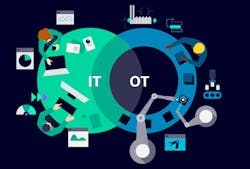Smart Manufacturing and the Convergence of OT and IT
Smart manufacturing approaches are enabling industrial companies to address the challenges of global competition, sustainability, supply chain snarls and labor shortages.
The goal is to become more efficient and drive the maximum utilization of factories. Manufacturers are discovering that digitalization is the new equalizer to achieve an innovative level of smart manufacturing. In the past, automation focused on reducing costs. But today, digitalization can take manufacturing processes to a whole new level if done right.
The foundation for achieving higher operation efficiencies is the convergence of OT and IT to uncover actionable insights. Using the wealth of data generated by factory operations technology (OT) from edge sensors and smart equipment, information technology (IT) can then store, retrieve, process, analyze and recommend action based on that digital data.
The actionable data leads to closed-loop manufacturing processes that are continually optimized and closed-loop product quality. Ultimately, it supports the creation of a comprehensive digital twin of the manufacturing environment to maximize throughput.
READ MORE: Siemens is Building its Future on Data—and its Own Land
IT/OT Fusion Delivers Actionable Insights
This article focuses on IT/OT convergence, which is the initial crucial step to achieving smart manufacturing. It helps to start with definitions for OT and IT:
- Operation technology (OT) – Provides the capabilities that run a factory. It includes all the software that goes into the operation of the physical equipment, the controls and the technology driving the machines, and the programmable logic controllers (PLCs). In other words, it helps the factory to function.
- Information technology (IT) – The organization’s computer information technology stores, which processes, analyzes and acts on data gathered from operations. Supervisors and management use IT to make decisions, while operation technology drives actions.
So where is the source of this data? Most factories today are a mix of older and newer equipment. Newer smart machines are designed to share data with a network, whereas older machines are data islands. A network of sensors is added to the factory to connect those islands to ensure robust data across all manufacturing operations, bringing operational data together for IT to analyze. These edge sensors can stream data to an entire range of measurements to provide a solid sense of the equipment’s performance. As a result, in almost every factory today, data is collected by various physical sensing technologies, including PLCs, sensors and gauges, IoT devices, etc.
READ MORE: Pointing to the Future, Siemens Celebrates its Legacy
Today, OT and IT are interacting more to achieve superior operational efficiencies. Traditionally, these were two distinct areas. But the search for greater operational productivity blurs the boundaries between traditional information management in server rooms and office buildings and operations management on the factory floor, providing essential data to improve overall operations.
OT and IT converge when information technology is captured as the factory floor is running, fed into IT systems that digitally optimize business decisions, looking at this data from edge sensors in smart machines. They can now better understand how the equipment runs to initiate real-time decisions. These decisions help to optimize and further maximize throughput from factories. Together, they assist in making critical decisions, uncovering a specific part of a machine that may be failing, running out of stock or having issues that impede factory production.
A simple example of one of the benefits of OT/IT convergence is monitoring air compressor operational trends. Experts estimate 30% of compressed air energy is wasted in leakage, with additional capital required to address capacity loss. By analyzing OT data regarding air compression, IT can quickly pinpoint inefficiencies in energy usage due to worn or leaking components, efficiently directing maintenance efforts to address them before they become significant energy losses. Maintaining near-zero leakage is an effective cost-saving benefit for manufacturers using substantial amounts of compressed air.
READ MORE: Software Integrates, Contextualizes and Governs Diverse IT and OT Metadata
Closed-Loop Manufacturing and Quality are now Attainable
Once all the key data is available on an ongoing basis from OT/IT convergence, it creates a connected feedback loop that strengthens the correlation between the as-planned product with the as-built and as-used product in a continuous, iterative process. Now, manufacturing engineering can receive timely feedback to make better choices for other critical manufacturing activities such as:
- Rescheduling the shop floor.
- Bringing in new support capabilities.
- Delivering proactive service before equipment fails.
It all leads to the goal of zero downtime.
With OT/IT convergence continuously enhancing manufacturing, it is now possible to pursue optimal product quality that includes long-term sustainability goals—such as zero waste. As a result, closed-loop quality ensures complete visibility of quality-related metrics from planning through delivering on the quality of the completed product. Closed-loop quality processes achieve a median product compliance rate of 99%, with a majority performance ranging from 97 to 100%. That means near zero waste without compromising on product performance or sustainability.
The Digital Twin of Production
Ultimately, OT/IT convergence lays the foundation for implementing a robust digital twin of the manufacturing environment. The digital twin is a virtual, digital replica of the physical objects of an entire machine, manufacturing system or shop floor in a digital environment. While the factory operates, the digital twin provides a physically accurate simulation of operations by combining the virtual and physical worlds to provide new insights and efficiencies for product manufacturing through data analytics and AI.
More data equates to a higher fidelity digital twin. And OT and IT convergence delivers the requisite real-time data and information to create a complete digital version of the factory. As a result, while the factory is running, the entire factory’s digital twin with each machine mirrors that activity in a replica, digital format. All that operational data ensures much higher fidelity of the digital twin and provides insight into real-world operations.
The comprehensive digital twin is the basis for improving the real-world version via simulation of the digital model, thus closing the loop for manufacturing operations and quality. In addition, it provides manufacturers with a mechanism to understand what will or could happen in the future. As a result, they can confidently use the digital twin for optimizing operations, predicting maintenance, enabling more efficient commissioning, better changeovers and faster production line changes. All critical capabilities for business operations to conduct their business more efficiently. And a change in a digital environment does not cost anything; it’s a zero cost. That encourages managers to examine a broader range of feasible approaches before committing to physical implementation on the production floor.
Rahul Garg is the vice president for Industrial Machinery & SMB Programs at Siemens Digital Industries Software, responsible for defining and delivering key strategic initiatives and solutions, and global business development. More information on Siemens Xcelerator, a comprehensive and integrated portfolio of software and services that can help companies realize digital twins, can be found here.
About the Author
Rahul Garg
Vice President for Industrial Machinery & SMB Programs
Rahul Garg is the vice president for Industrial Machinery & SMB Programs at Siemens Digital Industries Software, responsible for defining and delivering key strategic initiatives and solutions and global business development. He and his team are responsible for identifying key initiatives and developing solutions for the industry while working closely with industry leading customers and providing thought leadership on new and emerging issues faced by the machinery industry.
Garg’s experience and insight are derived from a 25-year career delivering software-based solutions for product engineering and manufacturing innovation for the global manufacturing industry, spanning a career in R&D to program management, sales and P&L management and having focused exclusively on the industrial machinery and heavy equipment industry since 2007.




